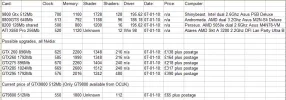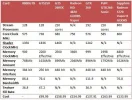- Joined
- Mar 5, 2002
- Messages
- 20,281
- Reaction score
- 1,794
I have to a certain degree lost touch with the latest graphics cards so I browsed around, read some reviews and then wondered how my own cards compared to the current crop.
So I listed all their specs and then took a typical sample from each Nvidia card family to see if at this time it was worth upgrading.
I would point out that I don't actually have any plans to upgrade atm, I was just curious.
Prior to compiling my table I did browse around, visiting hardware sites and other forums and gradually gained a feel for the latest cards and how ATI and Nvidia squared up to each other. The impression gained was that ATI have made giant leaps to catch up and have introduced new technology but, although Nvidia seem to be stuck in a mire with their chipsets, they still lead the field by a hair's breadth.
I've been happy with Nvidia for the last 8 years so for now I'll stick with them, but I will admit it's getting to be a close run thing.
Below is my Excel table showing at the top my 4 current graphics cards setups.
Motherboard memory, from 1 to 4, is: 4Gb; 2Gb; 2Gb; 1Gb.
The third spec listed is Nvidia 8200 onboard graphics and uses 128Mb max from system memory.
Below my specs are a typical card in each price range, prices taken from OCUK.
The table:

Several things struck me.
1) My onboard graphics has more or less the same spec as my three year old 8800GTS 640Mb in all but shaders and onboard memory.
2) In all the considered upgrades, all the price difference makes to the card is number of shaders and/or onboard memory.
3) Very little difference in clock and memory speeds, indeed, some higher priced cards run at slower speeds than their lower priced peers.
4) My current card - now considered a budget model - does have some respectable specifications, although it only has just over half the amount of shaders of all possible upgrades.
And therein lies the difference - shaders and memory.
Everything else is more or less constant through the whole Nvidia range, seems to me.
I wonder, then, does the extra money spent display itself pro-rata in terms of performance and eye candy?
All in all I was quite pleased I gathered the specs of my own cards as I was beginning to think I'd bought a turkey but all things considered it seems quite good. It's about two years old, I'd guess, at this time.
Most of the games I play on the GTX9800 I run at 1600 x 1200 and I get decent frame rates so for now I'll stick with it.
So I listed all their specs and then took a typical sample from each Nvidia card family to see if at this time it was worth upgrading.
I would point out that I don't actually have any plans to upgrade atm, I was just curious.
Prior to compiling my table I did browse around, visiting hardware sites and other forums and gradually gained a feel for the latest cards and how ATI and Nvidia squared up to each other. The impression gained was that ATI have made giant leaps to catch up and have introduced new technology but, although Nvidia seem to be stuck in a mire with their chipsets, they still lead the field by a hair's breadth.
I've been happy with Nvidia for the last 8 years so for now I'll stick with them, but I will admit it's getting to be a close run thing.
Below is my Excel table showing at the top my 4 current graphics cards setups.
Motherboard memory, from 1 to 4, is: 4Gb; 2Gb; 2Gb; 1Gb.
The third spec listed is Nvidia 8200 onboard graphics and uses 128Mb max from system memory.
Below my specs are a typical card in each price range, prices taken from OCUK.
The table:
Several things struck me.
1) My onboard graphics has more or less the same spec as my three year old 8800GTS 640Mb in all but shaders and onboard memory.
2) In all the considered upgrades, all the price difference makes to the card is number of shaders and/or onboard memory.
3) Very little difference in clock and memory speeds, indeed, some higher priced cards run at slower speeds than their lower priced peers.
4) My current card - now considered a budget model - does have some respectable specifications, although it only has just over half the amount of shaders of all possible upgrades.
And therein lies the difference - shaders and memory.
Everything else is more or less constant through the whole Nvidia range, seems to me.
I wonder, then, does the extra money spent display itself pro-rata in terms of performance and eye candy?
All in all I was quite pleased I gathered the specs of my own cards as I was beginning to think I'd bought a turkey but all things considered it seems quite good. It's about two years old, I'd guess, at this time.
Most of the games I play on the GTX9800 I run at 1600 x 1200 and I get decent frame rates so for now I'll stick with it.









 I dunno, you ain't here as often as you used to be
I dunno, you ain't here as often as you used to be